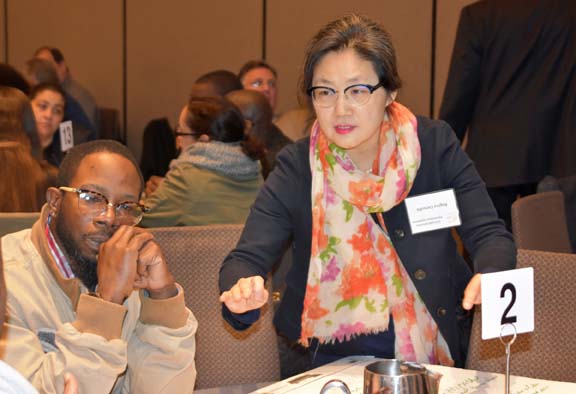An energetic group of more than 250 Environmental Services (EVS) workers, EVS managers and infection-control specialists attended a conference in October 2017 to learn about the vital role that EVS staff plays in infection prevention in hospitals and nursing homes. The conference was hosted by the Labor Management Project (LMP) in collaboration with 1199SEIU, the Greater New York Hospital Association and the League of Voluntary Hospitals and Homes of New York. Attendees heard from three prominent public health and infection prevention experts who spoke about environmental threats in healthcare settings and acknowledged the critical importance of EVS staff’s work to patient safety. In small-group breakout sessions led by LMP staff, participants discussed barriers that can keep them from performing their jobs properly and brainstormed ways around those barriers.
All three speakers provided recommendations for improving EVS worker training and cleaning processes, which can be found in PowerPoint presentations posted on the EVS conference page of our website. In addition, the NYS Department of Health has a training slides for EVS workers on its website.
At the conference, New York State Commissioner for Health Dr. Howard Zucker spoke about an emerging threat in New York City: a drug-resistant, easily spread and potentially deadly yeast, Candida auris, that was first discovered in the U.S. in 2016. Candida auris has already infected 92 people across 88 hospitals and long-term care facilities in New York State. What will stop it? Hand hygiene, contact precautions and environmental cleaning and disinfection, particularly of surfaces that get touched often. Dr. Zucker told EVS staff, “We cannot do this without you. This is a collaborative effort.”
“The hospital environment is a lot more important than we ever thought that it was,” said Dr. Arjun Srinivasan, Associate Director for Healthcare Associated Infection Prevention Programs at the Centers for Disease Control and Prevention. Unless we find a more effective way to address the problem, he said, antibiotic-resistant bacteria will be the leading cause of death by 2050, “Environmental services staff are far, far more than just people with mops. We need to get where we are all equal members of the healthcare team,” he said, to applause and cheers from the audience. Dr. Srinivasan was met with more applause when he said that EVS workers are, in fact, technicians, highly skilled in cleaning a complex healthcare environment.
Dr. David Calfee, Chief Hospital Epidemiologist at New York Presbyterian/Weill Cornell, urged attendees: “Consider yourself to be an important member of the infection prevention team.” Calfee drove home the point that high-touch surfaces in hospital rooms are frequently contaminated with germs, even after being cleaned. In a 2016 study, germs were found in one out of three hospital rooms after daily cleaning. In another study of 36 hospitals, over half of high-touch surfaces were not cleaned at discharged.
During a spirited afternoon session, teams of conference attendees brainstormed improvement ideas that could be immediately implemented at their worksites. Some teams pledged to review institutional cleaning policies and procedures. Others vowed to share what they had learned at the conference with their peers and management. Some teams talked about changing the culture at their institutions and taking on a more collaborative approach to their work. All teams expressed sincere enthusiasm about committing to change, marking the end to a very successful day.
